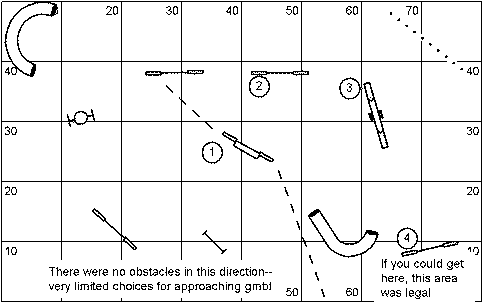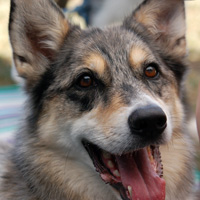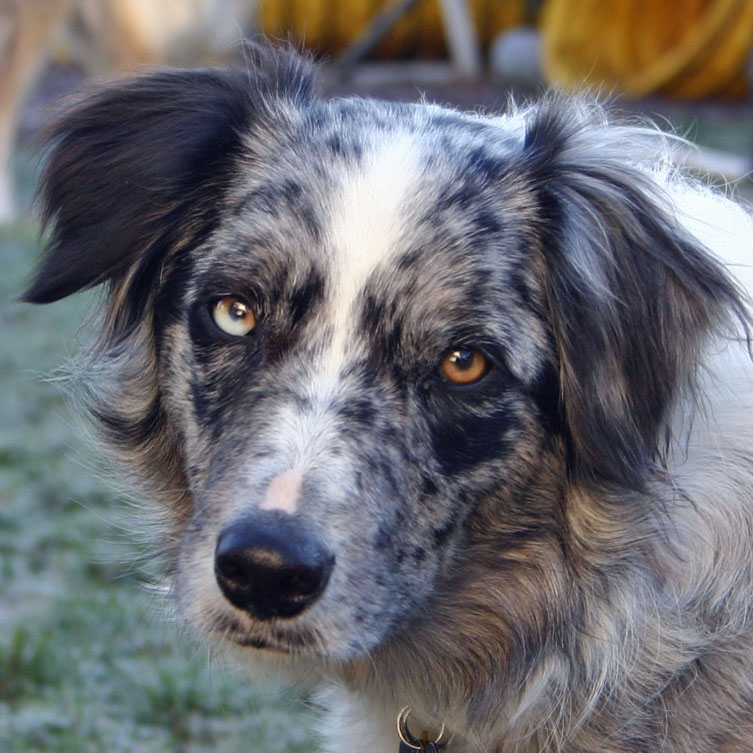Saturday's Infamous Gamble
Here's the Masters gamble from Saturday, which only 4 out of 66 Masters dogs completely successfully. (I did not include all of the obstacles on the course; this is only the lower left portion of the course showing the approach to the gamble, the gamble, and nearby obstacles that affected the gamble or the approach.)

Refresher on what a gamble is
A gambler's run has two parts:- In the opening, the handler invents a course around the field of obstacles, earning points for successfully completing obstacles. Each obstacle can be taken only twice for points. Jumps are worth one point; tunnels, tires, and 6-pole weaves have the same point value, which is higher than jumps; contact obstacles and 12-pole weaves have the same point value, which is higher than tunnels. Occasionally one obstacle is designated as having more points than any of the other obstacles, usually because it is a challenging obstacle in a challenging location. You need to collect a certain number of points to earn a qualifying score, so you necessarily do a simple or easy course (and usually the obstacle layout makes it challenging to design a course that flows well for the dog).
- In the closing, the dog must complete a numbered sequence of 4 to 6 obstacles--called "the gamble"--without the handler crossing the gamble line (dashed line on diagram).
The two tricks to this are the distance handling in the gamble and the time limits. You have a certain number of seconds to complete the opening (between 25 and 40, judge's choice), at which point a whistle blows. From that point, you have another limited number of seconds (usually 13-16) in which to complete the gamble. This means that you have to plan an opening course that puts you in a good position to begin the gamble when the first whistle blows.
You can be penalized if the judge thinks you are lingering near the start of the gamble--this occurs when you have already used up your two-times-for-points execution of obstacles near the gamble and continue to take the obstacles, or if you and your dog just run around or pause near the gamble. So course planning and timing are critical.
Why this gamble was hard
Especially for gambles like this, where the dog must go straight out away from you, you must have an approach to the gamble that gives the dog enough momentum to carry out over the obstacles. Because dogs rely so much on your body language, if you or the dog are moving slowly or if you stop abruptly at the gamble line, the dog is likely to pull up and turn back towards you.Several things contributed to the difficulty.
- The dog's tendency is to turn toward the handler. So, to send a dog straight out over 2 jumps and then have him turn right, your strongest approach would be with you on the dog's right. The gamble line's angle on the right of the jumps, however, means that your approach on the right side is effectively cut off quite a ways before the first jump.
- If you could get the dog beyond either of the two jumps on the lower left and then get yourself to the right side of those jumps, you might have a good approach going over either one of those jumps straight toward the gamble. But there's no good way to get the dog out there, and no easy way to get yourself to the far side.
- About the only other choice is to send the dog out *over* the jump closest to the tunnel, crossing behind him to get to the other side, then wrapping the dog tightly around the lower right side of that jump and running him at the gamble--but you have very limited room to move forward and you could easily lose momentum. You could try the same wrap around the other jump, which would give you more distance in which to build momentum, but the jump closer to the tunnel would be in your path, causing you to veer into the dog's path, aligning the dog to go straight over #1 to #3.
- There were not a lot of obstacles to make it easy to have an opening that ended near the gamble and allowed you to do two or 3 obstacles easily if you arrived early and still get yourself and your dog lined up appropriately when the whistle blew.
- The gamble starts with a double jump, which is more imposing than a single.
- Assuming that you get the dog over the 2nd jump, the angle of that jump compared to the first means that his stride is more likely to carry him to the left, even if you were on his right
- Assuming that he moves to the right after #2, a dog's tendency is to continue in as much of a straight line as possible--so a dog that carries out over #2 ironically might have the momentum to approach the weaves, which is the first obstacle in the dog's line of sight.
- A dog who is slowing down approaching #2 and makes a right turn around it will miss the teeter entrance, which is quite a way out from that jump.
- Assuming that your dog gets onto the teeter, he has now slowed down to complete the teeter successfully. Again, the dog's tendency is to veer towards you, so if you're near the left side of that tunnel, you have to push the dog out past two very visible and tempting tunnel openings to #4.
- Therefore you have an advantage if you can run past the tunnel and get up closer to #4 before the dog leaves the teeter. However, if you are very close to #1 while the dog is approaching #2, and if you turn around and start running around the tunnel before the dog has committed to #2, the dog will catch that motion in his wonderful peripheral vision and pull away from #2.
- You really have to move to get past that tunnel *after* the dog has committed to #2 and looks like he's going to make the turn onto the teeter and before he leaves the teeter.
So--lots of dogs never had the momentum to get over #2. Several turned left after it. Several blasted through so fast that their momentum took them out to the weaves. Several pulled away from #2 when the handlers moved too soon. Several didn't make the wide turn to the teeter. Several got onto the teeter but ended up in the tunnel. And several did the gamble correctly but because their approach was timed badly were over time.
Best strategy?
Good question. Probably to get you and your dog somehow behind that jump closest to the tunnel, then bring the dog on your left side over that jump and run stright towards #1. But you have to be behind the dog before then, because if you're even with him or ahead of him and stop suddenly at the gamble line, your dog won't carry out. For example, I walked the course with an approach with Jake going over the leftmost jump towards the lower left corner, then me running like heck between those two jumps to get far beyond the jump near the tunnel, essentially doing a front cross across Jake's path and switching him to my left side to go over that jump and into the gamble. Instead, when the whistle blew, I sent him out over the correct jump, but then crossed *between* #1 and the jump near the tunnel, so that when Jake came towards me over that jump on my left side, I was already almost at the gamble line and had to stop abruptly, so that he pulled away from jump #2 and came back.Ideally, you wouldn't have to run all the way in to #1, but would be able to send the dog in front of you over the lead-in jump then #1 and #2, with you slowing down and veering and turning slightly right near the left end of the tunnel to push the dog out to the teeter; then as the dog commits to the teeter, you wouldn't have far to run to get up behind the tunnel and push the dog over #4. Complete list of labels






0 Comments:
Post a Comment
Links to this post:
Create a Link
<< Home